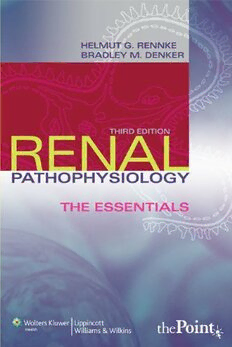
Renal Pathophysiology: The Essentials PDF
Preview Renal Pathophysiology: The Essentials
P1:OSO/OVY P2:OSO/OVY QC:OSO/OVY T1:OSO LWBK342-FM LWBK342-Rennke May15,2009 17:49 RENAL Pathophysiology The Essentials THIRD EDITION HELMUT G. RENNKE, M.D. ProfessorofPathology HarvardMedicalSchooland Harvard–MITDivisionofHealthSciencesandTechnology DepartmentofPathology Brigham&Women’sHospital Boston,Massachusetts BRADLEY M. DENKER, M.D. AssociateProfessorofMedicine HarvardMedicalSchool RenalDivision,DepartmentofMedicine Brigham&Women’sHospital ChiefofNephrology Harvard–VanguardMedicalAssociates Boston,Massachusetts i P1:OSO/OVY P2:OSO/OVY QC:OSO/OVY T1:OSO LWBK342-FM LWBK342-Rennke May15,2009 17:49 AcquisitionsEditor:CrystalTaylor ProductManager:StaceyL.Sebring MarketingManager:JenniferKuklinski Designer:TerryMallon Compositor:Aptara®,Inc. Printer:C&COffsetPrinting,Ltd Copyright© 2010LippincottWilliams&Wilkins 351WestCamdenStreet Baltimore,MD21201 530WalnutStreet Philadelphia,PA19106 Allrightsreserved.Thisbookisprotectedbycopyright.Nopartofthisbookmaybe reproducedinanyformorbyanymeans,includingphotocopying,orutilizedbyany informationstorageandretrievalsystemwithoutwrittenpermissionfromthecopyright owner. Thepublisherisnotresponsible(asamatterofproductliability,negligence,or otherwise)foranyinjuryresultingfromanymaterialcontainedherein.Thispublication containsinformationrelatingtogeneralprinciplesofmedicalcarethatshouldnotbe construedasspecificinstructionsforindividualpatients.Manufacturers’product informationandpackageinsertsshouldbereviewedforcurrentinformation,including contraindications,dosages,andprecautions. PrintedinChina FirstEdition,1994 SecondEdition,2007 LibraryofCongressCataloging-in-PublicationData Rennke,HelmutG. Renalpathophysiology:theessentials/HelmutG.Rennke,BradleyM.Denker.—3rded. p.;cm. Includesbibliographicalreferencesandindex. ISBN978-0-7817-9995-9 1.Kidneys—Pathophysiology. I.Denker,BradleyM. II.Title. [DNLM:1.KidneyDiseases—physiopathology. 2.Kidney—physiopathology.WJ300 R416r2010] RC903.9.R6722010 616.6(cid:2)107—dc22 2009013471 Thepublishershavemadeeveryefforttotracethecopyrightholdersforborrowed material.Iftheyhaveinadvertentlyoverlookedany,theywillbepleasedtomakethe necessaryarrangementsatthefirstopportunity. Topurchaseadditionalcopiesofthisbook,callourcustomerservicedepartmentat (800)638-3030orfaxordersto(301)223-2320.Internationalcustomersshouldcall (301)223-2300. VisitLippincottWilliams&WilkinsontheInternet:http://www.LWW.com. LippincottWilliams&Wilkinscustomerservicerepresentativesareavailablefrom8:30 amto6:00pm,EST. 06 07 08 09 10 1 2 3 4 5 6 7 8 9 10 ii P1:OSO/OVY P2:OSO/OVY QC:OSO/OVY T1:OSO LWBK342-FM LWBK342-Rennke May15,2009 17:49 Toourfamilies, StephanieandChristianne Mary,Brendan,Jennifer,andMackenzie iii P1:OSO/OVY P2:OSO/OVY QC:OSO/OVY T1:OSO LWBK342-FM LWBK342-Rennke May15,2009 17:49 Preface InthisthirdeditionofRenalPathophysiology:TheEssentials,wehave maintained the general principles that guided us in the design and ap- proach of the last two versions of the book. Over these last 15 years, we have received many comments and suggestions not only from our second-yearmedicalstudents,butalsofromhousestaff,nephrologyfel- lows,andcolleagues;wearemostgratefulfortheirfeedbackandencour- agingwords.Asaconsequenceofthesesuggestions,wehaveexpanded thesectionsonmolecularaspectsofthemechanismsthatresultinkid- neydysfunctionandthemorphologicexpressionofthemajordiseases thataffectthekidney.Theschematicillustrationsareintwocolorsand thelistofsuggestedreadingshasbeenupdated.Wehavealsoaddedsome colorimagesthatdepictthehistopathologychangesofthemajordisease processes that affect the kidney. The core and the principal aim of the bookremainunchanged:toprovidethestudentwithasolidunderstand- ingofthemechanismsthatresultinkidneydysfunctionanddiseaseand to serve as the basic reading material and text for a course in kidney pathophysiology. HGRandBMD iv P1:OSO/OVY P2:OSO/OVY QC:OSO/OVY T1:OSO LWBK342-FM LWBK342-Rennke May15,2009 17:49 Contents Preface iv CHAPTER 1 ReviewofRenalPhysiology 1 CHAPTER 2 RegulationofSaltandWaterBalance 32 CHAPTER DisordersofWaterBalance:Hyponatremia, 3 Hypernatremia,andPolyuria 69 CHAPTER 4 EdematousStatesandtheUseofDiuretics 99 CHAPTER Acid–BasePhysiologyandMetabolic 5 Alkalosis 126 CHAPTER 6 MetabolicAcidosis 156 CHAPTER 7 DisordersofPotassiumBalance 175 CHAPTER UrinalysisandApproachtothePatient 8 WithRenalDisease 199 CHAPTER PathogenesisofMajorGlomerularand 9 VascularDiseases 219 CHAPTER 10 TubulointerstitialDiseases 269 v P1:OSO/OVY P2:OSO/OVY QC:OSO/OVY T1:OSO LWBK342-FM LWBK342-Rennke May15,2009 17:49 vi Contents CHAPTER 11 AcuteRenalFailure 296 CHAPTER 12 ProgressionofChronicRenalFailure 317 CHAPTER SignsandSymptomsofChronic 13 RenalFailure 342 FigureCredits 367 Index 369 P1:OSO LWBK342-01 LWBK342-Rennke April30,2009 15:35 1 REVIEW OF RENAL PHYSIOLOGY OBJECTIVES Bytheendofthischapter,youshouldhaveanunderstanding ofeachofthefollowingissues: ■ Thegeneralmechanismsbywhichsolutereabsorptionandsecretion occurinthedifferentnephronsegments. ■ Thefactorsregulatingtheglomerularfiltrationrate. ■ Themechanismsbywhichtheglomerularfiltrationrateismeasuredin patients. Introduction Althoughreadersofthisbookshouldhavealreadycompletedacourseon normalrenalphysiology,abriefreviewofthebasicprinciplesinvolvedis helpfulinunderstandingthemechanismsbywhichdiseasemightoccur. Tubularfunctionswillbediscussedwithamajoremphasisonsodiumand 1 P1:OSO LWBK342-01 LWBK342-Rennke April30,2009 15:35 2 RenalPathophysiology:TheEssentials waterreabsorption.Theglomerularfiltrationrateincludingitsregulation andhowitisestimatedintheclinicalsettingwillalsobereviewed. Thekidneyperformstwomajorfunctions: ■ Itparticipatesinthemaintenanceofarelativelyconstantextracellular environmentthatisnecessaryforthecells(andorganism)tofunction normally. This is achieved by excretion of some waste products of metabolism(suchasurea,creatinine,anduricacid)andofwaterand electrolytes that are derived primarily from dietary intake. Balance or steady state is a key principle in understanding renal functions. Balance is maintained by keeping the rate of excretion equal to the sumofnetintakeplusendogenousproduction: Excretion= Intake+Endogenousproduction ■ Aswillbeseen,thekidneyisabletoindividuallyregulatetheexcre- tionofwaterandsolutes(suchassodium,potassium,andhydrogen) largelybychangesintubularreabsorptionorsecretion.If,forexam- ple, sodium intake is increased, the excess sodium can be excreted withoutrequiringalterationsintheexcretionofwaterorotherelec- trolytes. ■ It secretes hormones that participate in the regulation of systemic andrenalhemodynamics(renin,angiotensinII,andprostaglandins), red cell production (erythropoietin), and mineral metabolism [cal- citriol,(1,25-OHdihydroxyvitaminD),themajoractivemetaboliteof vitaminD]. Thekidneyalsoperformsanumberofmiscellaneousfunctionssuch as the catabolism of peptide hormones and the synthesis of glucose (gluconeogenesis)underfastingconditions. Relation between Filtration and Excretion Thenormalglomerularfiltrationrate(GFR)rangesfrom130to145L/day (90 to 100 mL/min) in women and from 165 to 180 L/day (115 to 125 mL/min) in men. This represents a volume that is more than 10 times that of extracellular fluid and approximately 60 times that of plasma; as a result, survival requires that virtually all of the filtered solutes and water be returned to the systemic circulation by tubular reabsorp- tion. Preventingexcessiveurinarysodiumlossisessentialtomaintenance oftheextracellularandplasmavolumes(seeChapter2).Figure1.1shows the organization of the nephron, and Table 1.1 lists the relative contri- butionofthedifferentnephronsegmentstothereabsorptionoffiltered sodiumandtheneurohumoralfactorsinvolvedinregulatingtransportat
